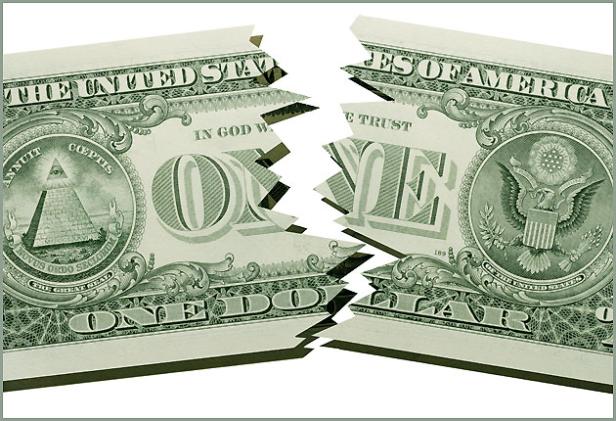numimaster.com | By Patrick A. Heller, Numismatic News | April 14, 2014
(This article was originally printed in Numismatic News.)

The U.S. Dollar Index has fallen below 80. Nations such as China, India, Iran, Russia, and others are seeking to eliminate the U.S. dollar in making payment for international oil transactions. It is not a joke to contemplate alternatives should the U.S. dollar continue falling in value so far that it might as well be worthless.
Actually, since the Federal Reserve was established in 1913, the value of the U.S. dollar has fallen more than 98 percent against an ounce of gold. There is no reason why this massive depreciation should stop at today’s level.
When the first Federal Reserve Notes entered circulation in 1914, either a $20 note or a $20 gold piece would purchase a top quality men’s suit. Today, the double eagle still can.
Back when U.S. 90 percent silver coins were circulating in the mid 1960s, you could purchase a gallon of gasoline for a quarter. Today, that same silver quarter will still buy a gallon of gasoline.
As the citizens of Indonesia learned when their nation’s currency plummeted in value during the 1997 Far East Currency Crisis, it wasn’t safe to have all of their wealth in paper assets denominated in the local currency. Those who did were pretty much wiped out. Indonesian citizens who owned gold saw their lifestyle largely unaffected.
The prospect of a failed U.S. dollar scares me. Look at the news reports of the civil unrest in Madrid, Spain, just last week. If the dollar collapses, I fear widespread unrest and chaos all across America.
In such a scenario, most Americans – those who do not own an insurance position of physical gold and silver, will lose most of their wealth and be poverty-stricken. Holding other currencies will not be sufficient as a sinking dollar will tend to drag down all paper money. Only those with the foresight and financial savvy to have physical precious metals in their direct custody will have ready alternatives for making purchases.
If you wanted to own precious metals solely on the basis of what would be most practical as potential spending money, here are some of my thoughts:
• Avoid platinum and palladium. The citizens of the world have no experience spending such metals. They have almost no history of monetary usage.
• Look for the units that represent the smallest value possible. A one-ounce gold coin or bar is easy to store and transport, but it would be difficult to make change if you wanted to buy a loaf of bread or a gallon of gasoline.
• Avoid coins and bars of pure gold (.9999 fine). Pure gold is such a soft metal that it dents and scratches easily. This advice does not necessarily apply in the Far East and Middle East, where pure gold is often the only acceptable form for trade.
• To start with, it would be helpful for each piece to be marked with its purity and net precious metal content. However, people living in most of history where gold and silver were spending money learned the relative metal value quickly. So, metal content of anything that circulated widely in decades past, such as U.S. 90 percent silver coins or British sovereigns, will be easy to spend.
• Although precious metals are traded in troy ounces of weight, I suspect that metric units will ultimately be more practical. Therefore, products containing an even number of grams of precious metal content might spend easier than those denominated in troy weights.
• Smaller European gold coins will tend to become popular even though their precious metal contents are not either in troy weights or metric units. British sovereigns (.2354 oz. gold, about 7.32 grams gold), French, Swiss, Belgian, Italian and other Latin Monetary Union 20 francs, or lire, (.1867 oz. gold, about 5.81 grams gold) circulated in many parts of the world.
• U.S. 90 percent silver coin has a distinct advantage of large available supplies, easy divisibility (where one dime contains almost exactly 1/14th of a troy ounce of silver), and is familiar to all Americans aged 55 and up.
• Initially, government-issued coins and bars are likely to be more trusted than private issues. Among private issues, long-recognized brand names such as Engelhard, Johnson Matthey, Credit Suisse and the like will tend to trade more readily than short-history brand names.
• Each part of the world will likely trade coins and bars fabricated domestically.
Here in the United States, I would establish holdings that include larger gold coins and bars (up to 50 grams in size and silver bars up to 100 troy ounces in weight to take advantage of lower premium levels. But, I would make sure to include smaller size gold coins such at the 1/10th and quarter-ounce American Eagles. I don’t know if the U.S. silver Eagles would continue to trade at a premium above private issue one-ounce rounds, but I would include some just in case. I would also own some well-known brand names (see COMEX-approved refiners and fabricators at http://www.cmegroup.com/trading/metals/gold-brands.html) widely available in America. Last, I would have a significant quantity of U.S. 90 percent silver coins. Because of their divisibility, I think they could easily end up being the preferred spending money in a post-U.S. dollar America.
What do you think?
Patrick A. Heller was the American Numismatic Association 2012 Harry Forman Numismatic Dealer of the Year Award winner. He owns “Liberty Coin Service” in Lansing, Mich., and writes “Liberty’s Outlook,” a monthly newsletter on rare coins and precious metals subjects.



